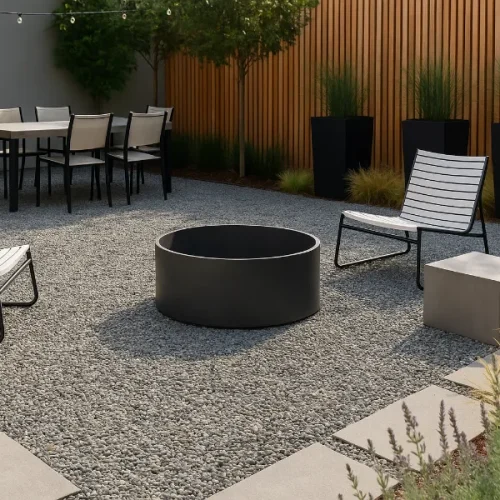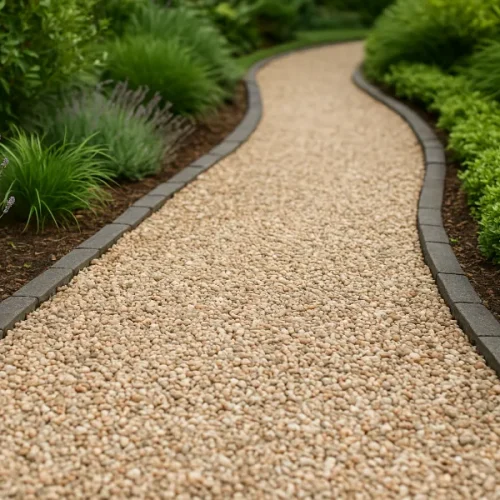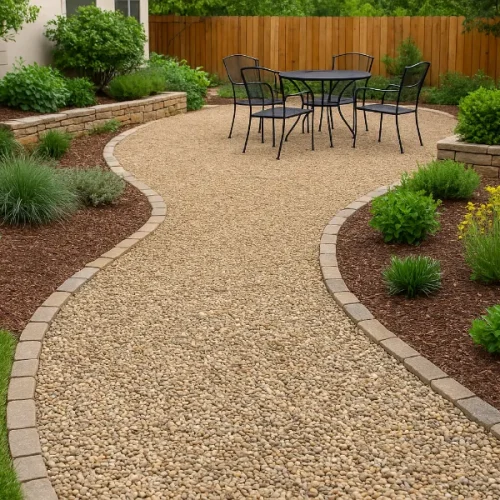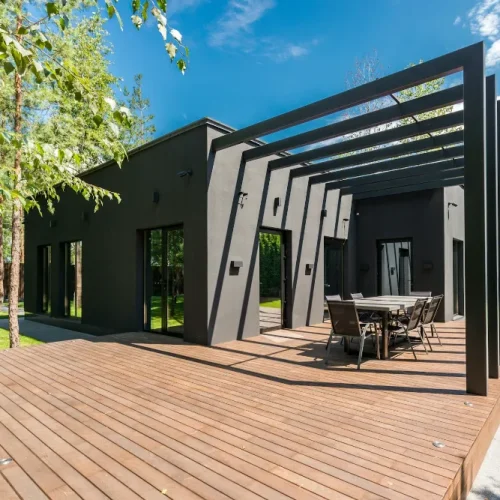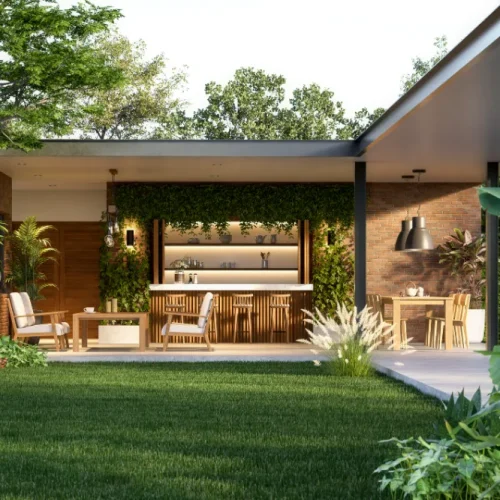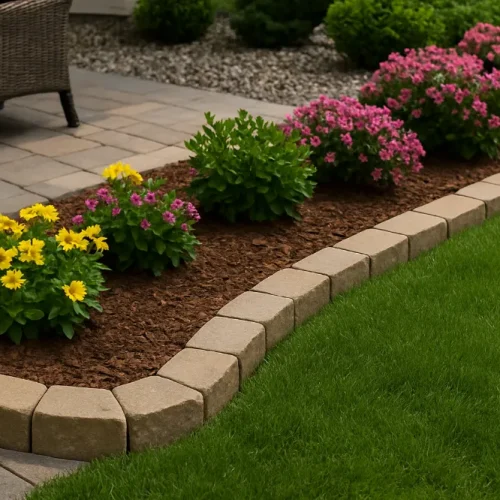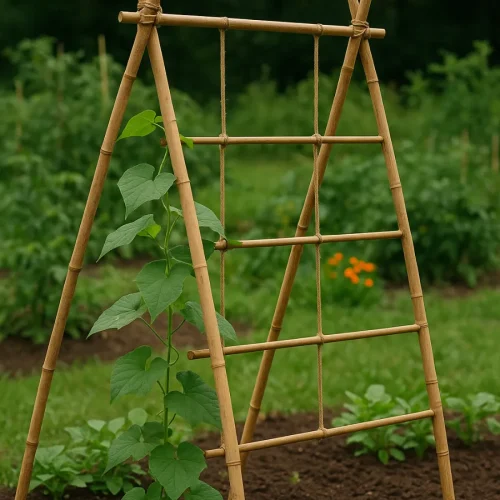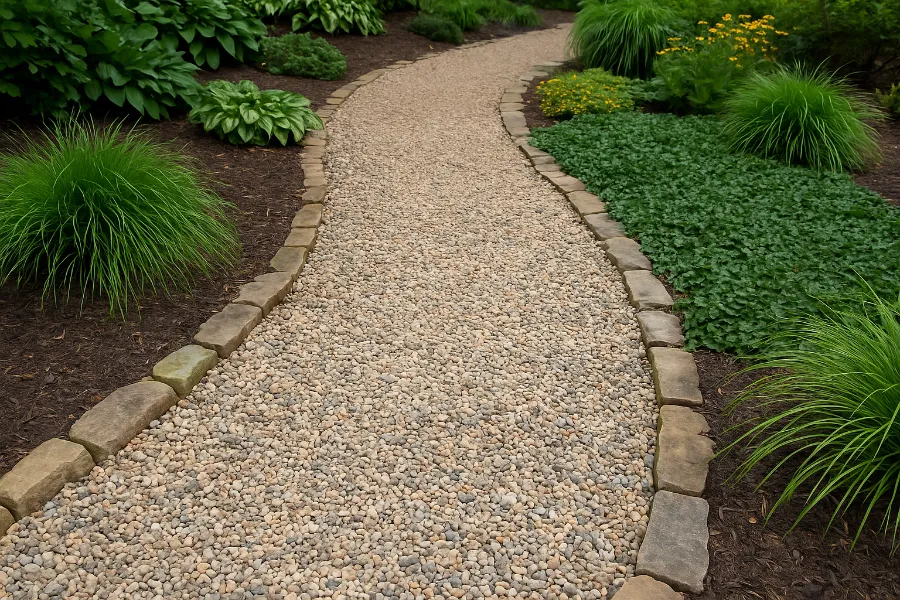
When it comes to designing an outdoor space that’s both functional and beautiful, garden pathways and walkways play a crucial role. They connect different areas of your yard, lead visitors through your garden, and set the tone for your landscape design. Among the many materials available brick, concrete, flagstone, mulch gravel stands out for its affordability, versatility, and natural charm. But not all gravels are created equal. The right type can enhance drainage, prevent weeds, and provide a comfortable walking surface, while the wrong one can lead to shifting stones, muddy patches, or uneven footing.
This in-depth guide explores the best types of gravel for garden pathways and walkways, along with expert advice on selection, installation, and maintenance so you can build a durable, low-maintenance path that complements your landscape perfectly.
Understanding Why Gravel Works So Well for Garden Paths
Gravel is a popular choice for pathways for several reasons. First, it’s cost-effective far cheaper than pavers or stone slabs and easy to install, even for DIY enthusiasts. It allows excellent drainage, preventing puddles and muddy spots during rainy seasons, and offers flexibility in design, whether you want a modern minimalist look or a rustic cottage garden vibe.
Gravel is also permeable, meaning it lets water pass through, reducing runoff and helping replenish groundwater. This eco-friendly feature makes it a favorite among sustainable landscaping enthusiasts. The U.S. Environmental Protection Agency highlights the importance of permeable surfaces for stormwater management and sustainable site design (EPA – Green Infrastructure).
Perhaps most importantly, gravel paths have a natural, timeless appeal. The crunch underfoot, the earthy colors, and the organic flow of a gravel walkway create a sensory experience that feels connected to nature.
Key Factors to Consider When Choosing Gravel
Before diving into specific gravel types, it’s important to know what to look for when selecting material for your path:
- Size of the Gravel
- For walking paths, smaller gravel (¼ inch to ⅜ inch) is ideal. Large stones shift too easily and can be uncomfortable underfoot.
- Fine gravel compacts better, giving you a stable, solid surface.
- Shape of the Gravel
- Rounded stones (like pea gravel) offer a softer look but may move around.
- Angular gravel (like decomposed granite or crushed stone) locks together better and stays in place.
- Drainage and Soil Type
- If you live in an area with heavy rainfall or clay soil, choose a gravel that promotes drainage.
- Sandy soils benefit from compactable options like crushed granite.
- Maintenance Requirements
- Some gravels need occasional raking or topping up.
- Consider edging to keep gravel contained and prevent it from spreading into your lawn or garden beds.
- Aesthetic and Color
- Gravel color ranges from earthy browns and grays to whites, golds, and pinks. Choose tones that harmonize with your home’s architecture and landscape style.
Best Types of Gravel for Garden Pathways and Walkways
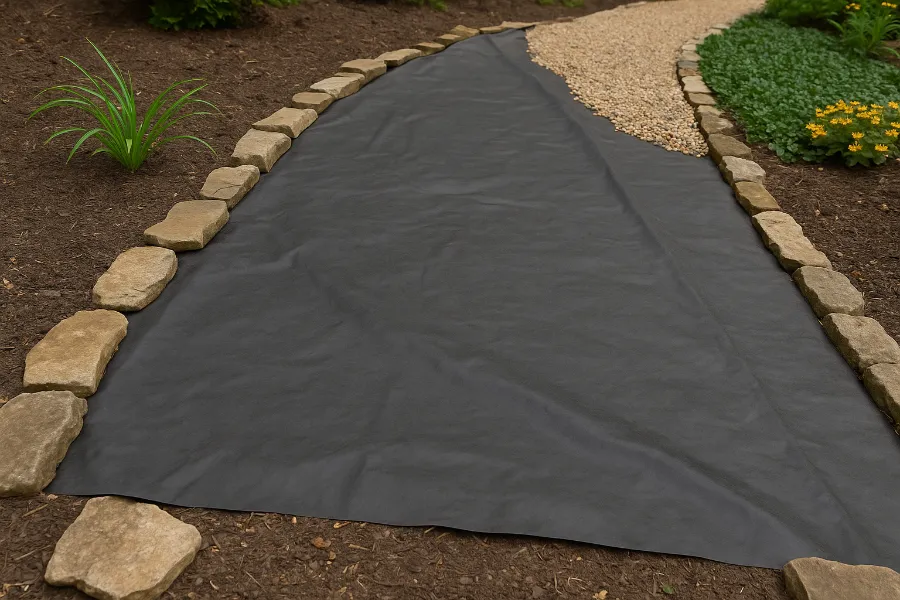
1. Pea Gravel
Best for: Decorative garden paths, seating areas, and informal landscapes.
Pea gravel is one of the most popular materials for pathways because of its smooth, rounded shape and natural beauty. The small stones about the size of peas come in soft shades of tan, gray, white, and brown, blending easily into any garden setting.
Pros:
- Comfortable underfoot, making it ideal for barefoot-friendly areas.
- Excellent drainage.
- Attractive, organic look.
Cons:
- Stones can shift easily without proper edging.
- Not ideal for slopes or high-traffic areas.
Installation Tip: Use a sturdy metal or stone edging to keep the gravel contained. A layer of landscape fabric underneath will prevent weed growth and keep the gravel from sinking into the soil.
2. Crushed Granite (Decomposed Granite)
Best for: High-traffic paths and modern landscapes.
Crushed granite, often referred to as decomposed granite (DG), consists of small, angular fragments that compact tightly to form a firm surface. It’s available in natural hues like gold, brown, and reddish tones, perfect for contemporary or desert-style gardens.
Pros:
- Excellent stability—stays in place even on slopes.
- Low maintenance and naturally weed-resistant.
- Can be used with stabilizers for a solid, accessible surface.
Cons:
- Can be dusty when dry.
- Needs periodic top-ups as it erodes slightly over time.
Installation Tip: For a more permanent solution, mix decomposed granite with a stabilizing binder before installation. This creates a hard surface that still allows water to drain through.
3. Crushed Stone (Limestone or Granite)
Best for: Durable, long-lasting walkways and driveways.
Crushed stone is a more angular material than pea gravel, giving it better interlocking properties. Commonly made from limestone or granite, it provides a strong, stable surface that handles foot and light vehicle traffic well.
Pros:
- Extremely durable and stable.
- Excellent drainage and load-bearing capacity.
- Works well as a base layer for other materials.
Cons:
- Can be rough on bare feet.
- Requires edging to prevent spreading.
Installation Tip: Layer the crushed stone over a compacted base and use a tamper to press it firmly into place. Top with a finer layer for a smoother walking experience.
4. River Rock
Best for: Decorative garden walkways and accent borders.
River rock features smooth, rounded stones that have been naturally shaped by water over time. It’s available in various sizes, typically ranging from ½ inch to 2 inches, and adds a decorative touch to gardens and water features.
Pros:
- Visually striking adds a polished, natural look.
- Excellent for drainage areas or dry creek beds.
- Durable and long-lasting.
Cons:
- Not ideal for walking paths stones shift and can be slippery.
- Heavy and expensive compared to other options.
Installation Tip: Use river rock as an accent material alongside a more stable path type. For example, combine it with stepping stones or pavers for visual balance and functionality.
5. Marble Chips
Best for: Formal gardens and light-colored landscapes.
For a bright, elegant look, marble chips can transform a basic garden path into something sophisticated. These white or light-gray stones reflect sunlight beautifully, creating a crisp, clean contrast with green plants.
Pros:
- Visually stunning and reflective.
- Long-lasting and resistant to weathering.
- Ideal for decorative edging.
Cons:
- Can be glaring in direct sunlight.
- Reflective surface may increase heat around plants.
- Pricier than most gravels.
Installation Tip: Use in shaded garden areas or alongside darker materials to balance brightness. Always install with landscape fabric to keep the chips from mixing with soil.
6. Jersey Shore Gravel
Best for: Coastal or rustic landscapes.
Named after the beaches where it’s found, Jersey Shore gravel consists of small, rounded stones in warm hues of yellow, gold, tan, and white. It evokes a coastal, relaxed aesthetic perfect for seaside-inspired gardens.
Pros:
- Attractive color mix complements greenery and water features.
- Smooth texture and excellent drainage.
- Easy to maintain with occasional raking.
Cons:
- Can scatter without edging.
- Slightly more expensive than standard gravel.
Installation Tip: Combine with stone or brick borders for a polished, contained appearance. Works beautifully with native grasses and driftwood features.
7. Slate Chips (or Crushed Slate)
Best for: Modern and contemporary landscapes.
Slate chips, sometimes called “shale gravel,” are flat, angular pieces of slate that give pathways a striking, textured appearance. Their deep gray, blue, or black tones make them a favorite for minimalist garden designs.
Pros:
- Elegant color and texture.
- Suppresses weeds effectively.
- Long-lasting and low maintenance.
Cons:
- Sharp edges not ideal for barefoot paths.
- Can flake or shift over time.
Installation Tip: For contrast, pair slate chips with lighter edging materials like limestone or pale concrete borders.
Choosing the Right Gravel for Your Garden Style
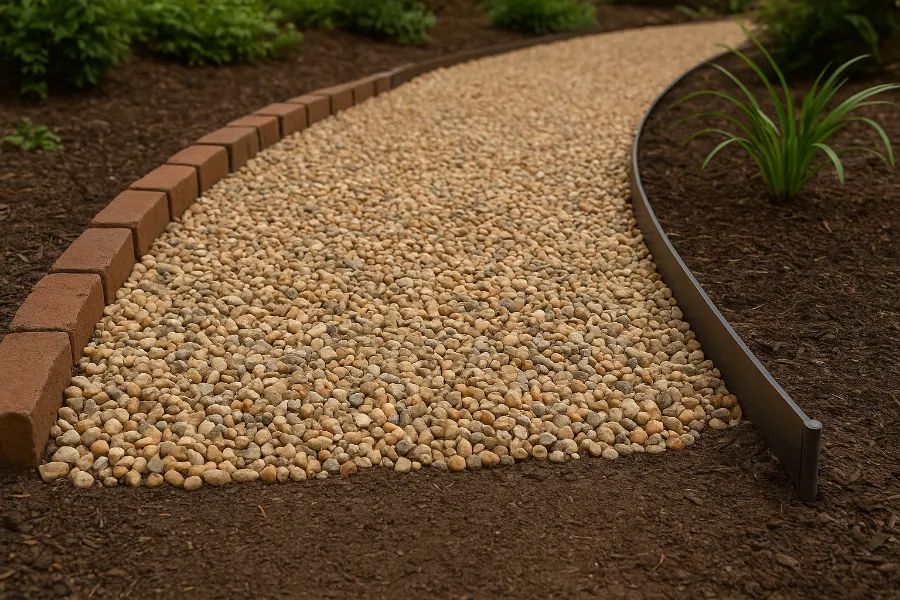
Your gravel choice should match both your aesthetic vision and practical needs. Here’s how to align the two:
- Cottage Garden or Rustic Look: Pea gravel or crushed granite blends naturally with soft, flowing plantings.
- Modern Minimalist Landscape: Slate chips or decomposed granite create clean, sleek lines.
- Mediterranean or Desert Garden: Decomposed granite or crushed limestone works well with succulents and xeriscaping.
- Coastal-Inspired Design: Jersey Shore gravel or light-colored river rocks bring a seaside charm.
For more detail on common gravel types, which provides a general overview of stone classifications, uses, and formation processes.
Step-by-Step Tips for Installing a Gravel Pathway
Even the best gravel won’t perform well without proper installation. Follow these essential steps for a professional-looking path:
- Plan Your Path
- Sketch your desired route and measure the width and length.
- Consider curves and natural flow straight paths feel formal, while winding ones add charm.
- Prepare the Base
- Excavate the area to a depth of 3–4 inches.
- Remove weeds, roots, and debris.
- Compact the soil with a tamper to create a stable foundation.
- Add a Weed Barrier
- Lay down landscape fabric to prevent weeds from sprouting through the gravel.
- Secure with pins or small stones at the edges.
- Install Edging
- Use metal, brick, or stone edging to keep gravel contained.
- Ensure edges are level and securely anchored.
- Add a Base Layer
- Pour a 2–3 inch layer of crushed stone or decomposed granite.
- Compact it thoroughly to prevent shifting.
- Add the Top Layer
- Spread your chosen gravel evenly, about 1–2 inches deep.
- Rake it smooth and level.
- Compact and Finish
- Use a tamper or roller to press the gravel into place.
- Lightly water the path to help the gravel settle.
Maintenance Tips for Long-Lasting Gravel Walkways
Gravel paths are low maintenance but not maintenance-free. Here’s how to keep yours in top shape:
- Rake regularly to redistribute stones and smooth out footprints.
- Add fresh gravel every few years to maintain depth and color.
- Control weeds by replacing worn-out landscape fabric or applying natural herbicides.
- Edge repair: Check edging for shifts or gaps to prevent gravel migration.
- Clean periodically: Hose down or blow off leaves and debris to keep the path tidy.
Eco-Friendly and Budget-Friendly Benefits
Aside from aesthetics, gravel walkways offer sustainable and cost-effective advantages. Because they’re permeable, they support better stormwater management, helping to prevent runoff and erosion. Gravel is also recyclable you can reuse it in other landscaping projects, such as drainage trenches or garden borders.
In terms of cost, gravel is typically three to four times cheaper than pavers or flagstone, making it an excellent option for large spaces or multi-path gardens.
Final Thoughts
The best gravel for garden pathways and walkways depends on your design goals, budget, and maintenance preferences. For most homeowners, pea gravel or decomposed granite offers the perfect balance of comfort, durability, and visual appeal. If you’re after a more polished or dramatic effect, marble chips, slate, or Jersey Shore gravel can elevate your landscape with color and contrast.
Whichever type you choose, remember that proper installation solid base, edging, and occasional upkeep will make all the difference. A well-crafted gravel path doesn’t just connect parts of your garden; it connects your home to nature, inviting every step to be a peaceful stroll through your personal oasis.
FAQs
Pea gravel and decomposed granite are the most popular options for walkways due to their comfort and stability.
Yes, pea gravel is great for light-use paths—it’s smooth, affordable, and offers a natural look, though it may shift without edging.
A gravel path typically needs 2–3 inches of compacted gravel for proper drainage and stability.
Yes, a compacted base layer of crushed stone or decomposed granite ensures the gravel stays level and prevents sinking.
Install edging using metal, stone, or brick to hold the gravel in place and maintain a clean border.
Decomposed granite and crushed stone are highly permeable and promote excellent water drainage.
Yes, especially with smooth pea gravel, which is gentle underfoot and ideal for barefoot-friendly garden areas.
Every 2–3 years, top up with a thin layer of fresh gravel to maintain depth and appearance.
Crushed limestone or decomposed granite are affordable, durable, and easy to install for budget-friendly projects.
Yes, gravel is naturally porous and allows rainwater to soak through, reducing runoff and preventing muddy spots.





